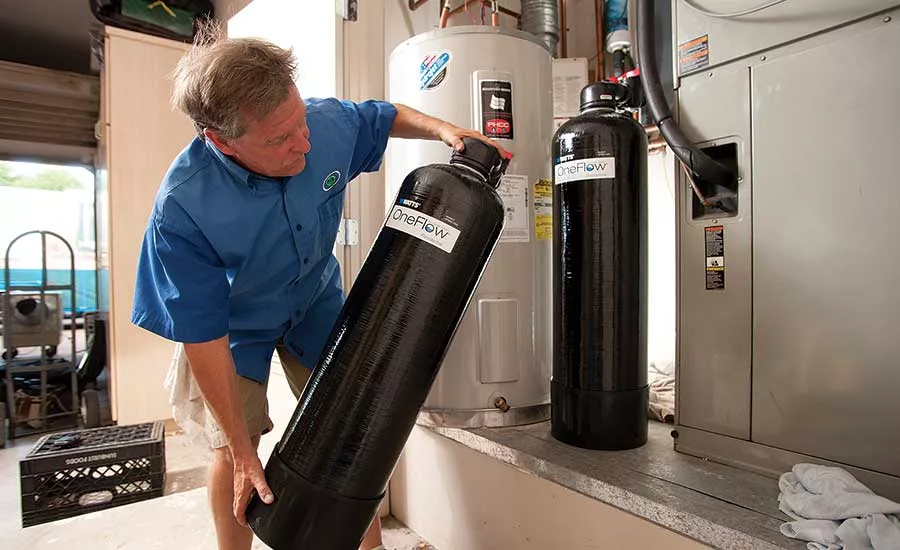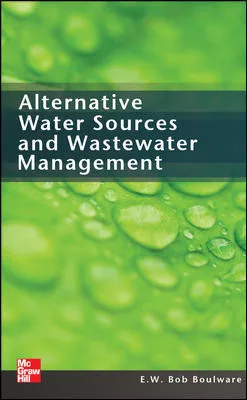Interest Surges for Water Quality Market
The aftermath of Flint, Michigan, opened consumers’ eyes to water treatment solutions.

A technician installs two Watts OneFlow (template-assisted crystallization) water treatment tanks at a customer's home. OneFlow technology eliminates the need for water-softening salt, and requires no electricity. Photo credit: Watts Water Quality

Recent reports from the Michigan Department of Environmental Quality show the lowest level of contamination since the water crisis began in Flint, Michigan in 2014. The agency reports 90% of Flint water samples had 4 parts per billion of lead or less in the last six months of 2018. The unfortunate event served as a cautionary tale on a national level and boosted water quality awareness in communities around the U.S.
“Sadly, our water infrastructure is failing and desperately in need of repair,” says Mike Trammell, general manager and senior product manager, Watts Water Quality. “There are many facets to the repairs and improvements so badly needed, but funding is typically the key problem. Another aspect of it is that the needed repairs also require a lot of time; we’re well beyond the ‘quick-fix.’ We’re also seeing that when needed infrastructure repairs are begun — such as large, municipal pipeline replacements — high levels of contamination can be released by the dislodging of bacteria and pollutants that were deeply embedded in fairly stable, decades-old sediments and biofilm. So, to fix a problem, we create substantial new ones.”
According to Trammell, one of the largest concerns is the growing presence of Perfluorooctane Sulfonate (PFOs) and Perfluorooctanoic Acid (PFOAs) in drinking water supplies.
“Over the past 10 years or so, there’s been growing concern about these man-made chemicals once used to manufacture a wide range of consumer goods, from Teflon pans to paper products and boxes, to carpeting,” he says. “PFOs and PFOAs have found their way into soil, air and water, especially around urban and manufacturing areas, and military installations. And, as we now know, groundwater, runoff, streams and air movement transports pollutants great distances. Today, they pose significant risk to humans and wildlife.”
However, the industry is making progress, notes Justin Barker, vice president of sales, Enviro Water Products.
“This is the first time we can really truly recognize the plumbing and wholesale industry is acknowledging that the water treatment needs of the end consumer are just not being met,” Barker says. “More and more consumers today are asking the professional in their home — whether it be a builder or a plumber — about water treatment. For years, plumbing contractors wouldn’t provide this type of service, but now they’re thinking, ‘Wait a minute, why don’t I offer this?’ They realize it’s a growing market. The trend for water treatment is paralleling the trend for organic foods, skincare market and the bottled water market.”
With more plumbing companies adding water treatment services, Enviro has built a website allowing contractors instant access to everything from videos that talk about the way carbon addresses the chemicals in the water to protect the family in the home and how the EnviroSoft Salt-Free conditioner media converts hardness minerals into neutral harmless calcium carbonate and protects the home from scale.
“Those concepts of water treatment can be easily explained in these videos instead of having the plumber memorize what our systems do,” Barker says. “They can simply put an iPad in front of the customer while on any given plumbing call and say, ‘I don’t know if you’re aware, but this is what’s going on in your water. We have this great product to treat that. Take a look at the video.’ And it really opens the doors for a contracting business owner to bring on water treatment without having to make his entire team of plumbers water treatment experts.”
Mature Market
The residential, commercial, industrial and small community water treatment industry is very mature, according to Tom Bruursema, associate executive director of member and public engagement, Water Quality Association (WQA).
“They’ve been developing and providing point-of-use, point-of-entry and related technologies to meet water quality treatment needs for decades,” Bruursema says. “So as the existing and new emerging contaminants continue to rise in awareness, this industry has continued to develop technologies and solutions to meet those needs, providing a final barrier for improved quality. This industry has never been better positioned to respond — and respond rapidly — to the widespread variety of consumer needs.”
Bruursema notes the biggest trend in the market is the increased awareness amongst the average consumer. Consumers are much more informed, and more interested in having information on knowledge about their water supply, whether it be a public or private supply.
“Flint, Michigan was unique because it was a national, if not international story that generated a lot of visibility and awareness to water quality issues,” he says. “What was unique about it was it concerned a public water supply, so it created a tremendous amount of visibility to the consumer. These types of water quality related events are continuing to drive consumer interest to better understand water quality issues. They begin to raise questions: ‘What things should I be doing?’ to ensure the water they have meets their particular needs.”
This holds true for Endwell, New York-based Arctic Bear Plumbing, Heating & Air and its spinoff, Arctic Water.
“Since Flint, we’ve tested a lot more for lead,” says Evan Grubb, sales manager of Arctic Bear and co-owner of Arctic Water. “A lot of people weren’t aware of what caused that, so we educate consumers on why those things would happen, what to look for, how to identify it, how to remove the lead from the house if that were to happen and replace plumbing, old fixtures and faucets. There are still lead pipes in a lot of homes. In our area, we had a similar situation, but on a much smaller scale. Some of the schools put out reports. So even on a local level, awareness is increasing.”
Grubb points to the increasing sales of bottled water in stores as evidence of the trend.
“It shows a desire to find quality drinking water — people want that in their home, and that’s where we come in to provide that on a continual basis versus always buying bottled water from the store.”
Most of Grubb’s job consists of education customers.
“They typically call us when they’re made aware of an issue or read a report on water quality and have concerns,” he says. “The most common issue we see would be hardness, which is really a combination of things, but primarily calcium in our area. Iron is also an issue. Municipal water in our area also has chlorine because they use it to kill bacteria. But a lot of people are realizing the chemical side of chlorine and the effects that it has. So we’ll treat the hardness and remove the chlorine, making it safer to use and consume.”
New Challenges
The biggest challenge is educating consumers that just because they’re not drinking the water, doesn’t mean it’s not having an adverse effect, according to Barker.
“People don’t realize it’s what they shower in, it’s what their skin is absorbing every day,” he says. “The chlorine in the shower is really effecting their skin and hair. And the exposure rate is dramatically more than what they’re consuming potentially. Getting that information out to the public can be a challenge.”
However, awareness campaigns are getting better and more Americans search online for ways to get water filtration in their homes, Barker notes.
“It’s a legitimate concern,” he says. “Interestingly enough, when Flint happened, I read that it wasn’t people in Flint that overloaded the internet. It was people from all over the country searching for information — maybe they knew someone in Flint or it got them thinking about the infrastructure in their own towns. People should be concerned about gaining infrastructure. If things go wrong, if piping is not maintained and it breaks, there is bacteria entering the water lines and cities send out boil water alerts. But the reality is, how quickly can these cities respond? We have products to alleviate those concerns that should bad things happen, the end user still has safe, clean water in their home.”
Aging infrastructure remains a key challenge, Trammell notes.
“Water treatment facilities are still working with older technologies,” he says. “The reason for concern is that there are new contamination problems (PFOs and PFOAs) — and newer, improved technologies may offer better, more effective treatment. Which brings us back around to higher costs, and the need for funding.”
Another problem is the lack of real-time monitoring.
“The old adage, ‘You don’t know what you don’t know’ comes to mind,” Trammell says. “Consider Flint — they were blindsided by the problems they faced. And they were forced into a painful, way-too-slow reactive mode. Similarly, our growing problems with PFOs and PFOAs can be fixed — but we need to know about them, and where they are before improvements can be implemented. And, it’s far better to prevent problems before they arise. We need to be more diligent with monitoring and treatment.”
Looking for a reprint of this article?
From high-res PDFs to custom plaques, order your copy today!










